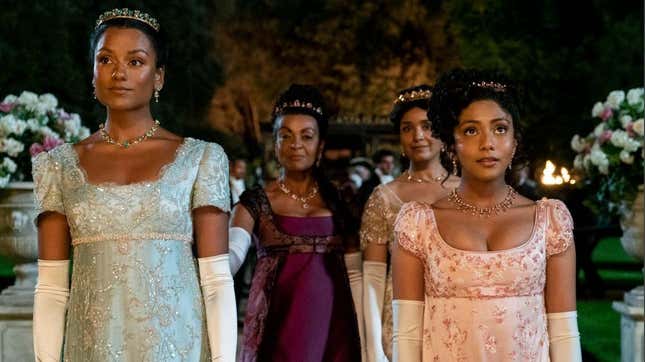‘Bridgerton’ Season 2 Skims the Surface of Lust—and Lets Its Leading Women Down
Pegged to center the Sharma sisters, the forbidden passions in Season 2 are vanilla at best. There's a reason for that.
EntertainmentTV

Let the record show that I did not come to see Bridgerton Season 2 for the bodice-ripping or taut nipples; I came for the strong women. The unequivocally distinguished Lady Danbury as the fierce protector of love, honor, and family. Queen Charlotte’s role as the authoritative aunty with a secret heart of gold. Lady Bridgerton’s quiet, poised wisdom. Even Lady Featherington and her underestimated wit, will, and gumption in advocating for her daughters at any cost. And I especially came to see the young heroines—Penelope and Eloise, Kate and Edwina—establish their voices and stake their claims on the seemingly male-dominated Bridgerton world.
As the many critiques of Season 1 outlined, Bridgerton prided itself on being boundary-pushing by casting historically underrepresented actors of color throughout a sort of color-blind society. That cultural expansion rested mainly on the shoulders of Simon, Lady Danbury, Marina, and the Queen, and we got little insight into their their humanistic qualities or backstories. We never saw who these characters were when they weren’t consumed with sex or white trauma. Though Season 1 bucked its ultimate responsibility as a period piece by failing to dive deep into the real interworking of all its characters of color, it was more successful when it gave us glimpses of its single female characters’ ability to triumph without male counterparts to lean on. But just glimpses they were.
Season 2 of Bridgerton, which lands on Netflix this Friday, could have enticed our palates with more than mere glimpses. And because many of its leading women are characters of color, it could have showered us with flashbacks, memories, and insight into what it feels for them to navigate this kind of society. According to showrunner Chris Van Dusen, casting three South Asian women as lead characters was a way to expand culture within the Bridgerton landscape (perhaps to move past criticisms of tokenism), but Season 2 timidly skimmed the surface of such representation when I needed it to leap into sumptuous storytelling. I couldn’t escape into it while I was also trying to navigate its unsatisfying approach to inclusivity.
Season 1 left off with a less than ideal state of things that was intriguing all the same. Newlyweds Daphne and Simon started a family, Siena chose herself over Anthony, Madame Delacroix focused on furthering her Modiste shop, the Featherington women fended for themselves, Penelope persisted as the elusive author, and Eloise and Queen Charlotte remained in a parallel quest to find the true identity of Lady Whistledown. Or at least, that is the vantage point I chose to lean into—the one where the women were in control of their destinies, holding the reins, riding bareback. And wouldn’t that have been lovely? For women to show up with agency and autonomy in a world that had already decided to screw the rules of race, colonialism, and class?-

-

-

-

-

-

-

-

-

-

-

-

-

-

-

-

-

-

-

-

-

-

-

-

-

-

-

-

-

-

-

-

-

-

-

-

-

-

-

-








































